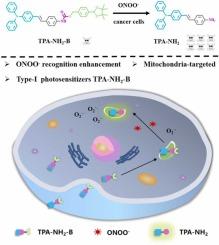线粒体靶向光敏剂的 ONOO- 调节 ICT,以增强 I 型光化学反应
IF 3.7
1区 化学
Q1 CHEMISTRY, ANALYTICAL
引用次数: 0
摘要
通过调节病变区的供电子基团和吸电子基团,可以有效提高基于ICT的I型光敏剂的光化学反应效率。基于这一策略,本研究以苯硼酸频哪醇酯基团作为ONOO-的识别基团,设计合成了一种线粒体靶向光敏剂(TPA-NH2-B)。这种分子结构在响应 ONOO- 前后表现出明显的 ICT 变化。ICT 作用较弱的 TPA-NH2-B 能在 15 秒内迅速与 ONOO- 发生反应,生成 ICT 作用较强的反应产物 TPA-NH2。对 ONOO- 的反应过程伴随着高级 ICT 的实施。用 DHR123 进行的电子顺磁共振实验和光谱分析显示,TPA-NH2-B 与 ONOO- 反应后,ROS 生成增加。同时,TCNQ 实验结果表明,与 ONOO- 反应后,淬灭常数增加了 5.7 倍,表明 I 型 PDT 过程中的电子传递效率得到了提高。在活细胞中,TPA-NH2-B 对 ONOO- 的反应过程也得到了证实。TPA-NH2-B 的线粒体靶向性强,光毒性好,暗毒性低。最后,肿瘤实验验证了 TPA-NH2-B 在光照射下能有效产生 ROS,导致细胞死亡并抑制肿瘤生长。上述实验证明,基于 ICT 机制的光敏剂可以通过调节 ICT 的效率来调节光化学反应的效率。本文章由计算机程序翻译,如有差异,请以英文原文为准。

ONOO- regulating ICT of mitochondria-targeted photosensitizers to enhance Type-I photochemical reactions
The photochemical reaction efficiency of ICT-based Type-I photosensitizers can be effectively enhanced by the regulation of electron-donating and electron-withdrawing groups in the lesion area. Based on this strategy, a mitochondria-targeted photosensitizer (TPA-NH2-B) was designed and synthesized in this study, using benzeneboronic acid pinacol ester group as recognition group for ONOO-. Such molecular structure exhibits significant ICT change before and after responding to ONOO-. TPA-NH2-B with weaker ICT effect rapidly responds to ONOO- within 15 s and form the reaction product TPA-NH2 with strong ICT effect. The response process for ONOO- is accompanied by the implementation of advanced ICT. Electron paramagnetic resonance experiments and spectrum assay with DHR123 showed an increase in ROS production after TPA-NH2-B reacted with ONOO-. Meanwhile, TCNQ experiment results show that the quenching constant increased by 5.7-fold after responding to ONOO-, indicating that the efficiency of electron transfer during Type-I PDT process has been enhanced. In live cells, the response process of TPA-NH2-B to ONOO- has also been confirmed. TPA-NH2-B showed high mitochondria targeting, good phototoxicity and low dark toxicity. Finally, tumor experiments validated that TPA-NH2-B efficiently generates ROS under light irradiation, leading to cell death and inhibiting tumor growth. The above experiments prove that photosensitizers based on ICT mechanisms can adjust the efficiency of photochemical reactions by regulating the efficiency of ICT.
求助全文
通过发布文献求助,成功后即可免费获取论文全文。
去求助
来源期刊

Sensors and Actuators B: Chemical
工程技术-电化学
CiteScore
14.60
自引率
11.90%
发文量
1776
审稿时长
3.2 months
期刊介绍:
Sensors & Actuators, B: Chemical is an international journal focused on the research and development of chemical transducers. It covers chemical sensors and biosensors, chemical actuators, and analytical microsystems. The journal is interdisciplinary, aiming to publish original works showcasing substantial advancements beyond the current state of the art in these fields, with practical applicability to solving meaningful analytical problems. Review articles are accepted by invitation from an Editor of the journal.
 求助内容:
求助内容: 应助结果提醒方式:
应助结果提醒方式:


